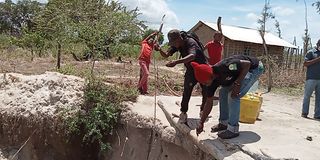Premium
Collaboration key in dealing with disasters, stakeholders say

Residents of Hindi-Magogoni villagers fetching water from an open well as drought ravages Lamu County.
Government agencies at all levels should collaborate to ensure enough resources are available to enable communities in high-risk areas prepare for and respond to disasters on time.
In any case, stakeholders always know that a crisis will happen, but the only mystery is when it will occur.
As such, a timely and effective response to shocks requires advance real-time budgeting.
These were some of the sentiments that came out strongly during a recent USAid Kenya and East Africa Horn of Africa learning event organised by the Resilient Learning Activity (RLA).
The online forum brought together stakeholders from the Horn of Africa and other countries from across Africa.
It sought to bring to light the sharing of lessons learned and draw recommendations on what needs to be carried forward or improved in building resilience for communities, especially due to climate change and the shocks that come with it.
Holistic approach
RLA Deputy Chief of Party Ibrahim Somo, who was among the facilitators, said there is a need to move from just addressing drought to a more holistic approach which includes addressing other shocks.
“If we got budgeting, policy and leadership right, we will be in a better position towards addressing drought and other shocks,” said Mr Somo.
The Director of the Office of Economic Growth and Integration at USAid Kenya and East Africa noted that the Horn of Africa, like many parts of the globe, has faced various shocks in the recent past.
Some of these include the current Covid-19 pandemic, locusts invasion, drought and floods.
Increase adaptability
USAid, he added, seeks to increase adaptability to the current shocks.
“We work to transition communities from being recipients of emergency relief to having the capacity to prepare for and recover from shocks,” he said, adding that this is achieved through working with governments, development partners and regional bodies.
The Chief Executive Officer of the National Drought Management Authority in Kenya, Mr James Oduor, took participants through critical elements that are needed to strengthen the resilience of local communities, including political goodwill, strengthening of policies and multi-sectorial collaborations.
This comes at a time when USAid has launched the Horn Regional Resilience Framework 3.0, whose development and design have been a collaborative effort from the Horn countries including Kenya, Ethiopia, South Sudan, Uganda, Somalia and the Democratic Republic of Congo.
Standard reference
The framework will serve as a standard reference for resilience programming throughout the region. Additionally, the framework seeks to inform the programme designs to ensure they are risk-informed and shock-responsive.
Its intended outcome is increased resilience of chronically vulnerable individuals, households, communities and systems.
By being resilient, communities can anticipate, absorb, adapt to and be transformative to climate change and the shocks that come with it.
Call for vibrant synergy
Participants called for vibrant synergy, including multi-sectorial and cross-border approaches in enhancing resilience and adoptability among communities.
This can be achieved by empowering communities and supporting multi-sectorial resilience programming.
“Covid-19 pandemic and climate shocks have demonstrated that no one is immune to shocks and stresses which threaten development,” noted Andre Mershon, a senior resilience specialist at the Centre for Resilience, USAid’s Bureau for Resilience and Food Security.
He noted that building resilience matters everywhere and in all scales.





